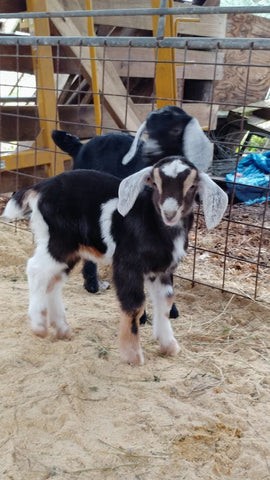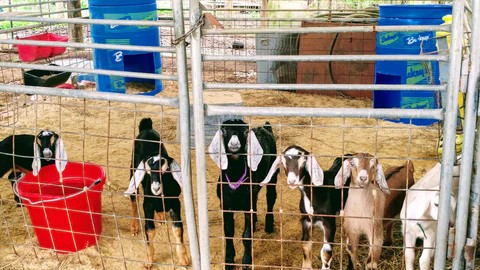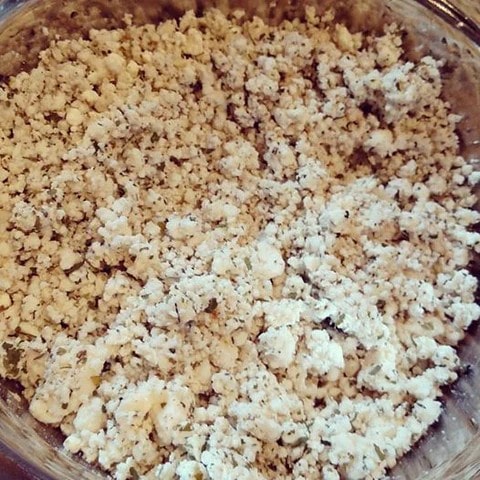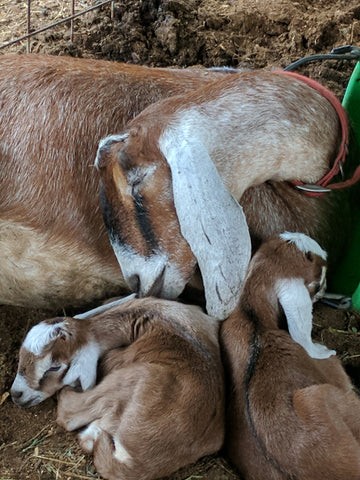
Feeding baby goats (kids) their bottles is my favorite farm chore. I am rewarded daily by their happy little personalities. The kids see me bringing the bottles to the barn and their chorus begins immediately.
If you aren’t familiar with baby goats sounds, you might think that something is terribly wrong because of the way they scream for the bottle. And, let’s not forget the extra chatty kids that may sound like a human child yelling for help. Just ask my neighbor that lives half of a country block away. He drove over one night at 10 o’clock to find out where the child was that was screaming, “Help! Help!” over and over. We pointed to the goat and laughed. Our neighbor didn’t laugh; he had been very worried. We apologized for the noise and he was glad that everyone was safe.
Feeding baby goats really is a time-consuming chore when they are newborns, but after a week, the process becomes easier, and more enjoyable, too! Let me explain. Beginning with days 1 through 3, both the baby goat and I are wearing about equal portions of the 3 daily bottles, by day’s end. Once the kid has mastered drinking from the bottle, the little tail takes over and the fun begins. Now, as soon as the baby sees the bottle, that tail consistently wags back and forth like crazy and continues through the meal. It is adorable.
The kids’ other senses engage toward the end of the first week of life. They recognize me by sight and sound. When the back door to the house closes, their little yelps begin. Those yelps change to screams of pure joy when they see me and then, the tails start again.
 Imagine the time needed to prepare more than ten bottles, three times every day!
Imagine the time needed to prepare more than ten bottles, three times every day!
I fill a 20 oz bottle for each baby and warm in hot water until comfortable to my touch. A goat’s body temperature is 102 degrees Fahrenheit, so warm bottles are necessary. During kidding season, I do stay home most of the time to ensure that my baby goats get the best start in life.
Why do I bottle feed instead of letting the dams raise the babies?
A dam has two teats, so when triplets are born, there are not enough places for babies to all eat at the same time. Unfortunately, one kid will get less food than the other two. My solution is to pull one kid and bottle feed, but that doesn’t mean I take the kid away. I’m now providing a healthy start for all three. Additionally, the dam can stay strong and healthy while feeding twins, instead of struggling to feed triplets.
Have you ever heard the term first freshener? Well, a young doe that kids for the first time (first freshener) may need lots of time and practice at becoming a good mom. Instead of making hungry babies wait for mom to settle down and be still so they can eat, I give them bottles so they are full and content, that way their dam has time to figure out how to care for her kids. She can devote her time to cleaning and talking to her babies, even if she never actually feeds them. I promise you, those babies will not go hungry!

Bottle babies drink up to 20 ounces of milk, three times per day. Any more milk than that will delay the natural curiosity kids have to nibble on hay, weeds, and eventually, grain. I believe that the sooner babies begin eating hay (alfalfa hay is the favorite), the healthier they will be. What does the alfalfa hay provide? Alfalfa hay provides the ideal amount of protein needed to keep dairy goats healthy during the lactation period. Alfalfa hay provides more protein, vitamins, and minerals than grass hays. And the goats love it! I put out hay every afternoon and they all come running before I even get the barn door open. It is like their afternoon treat.
Where does the milk come from that you feed them?
Bottle babies are fed only their dam’s raw colostrum and milk for the first ten days of life. Whenever possible, and when the dam is attentive to her kid, I keep them together. There is nothing like nurturing from momma.
The next two weeks the babies receive milk from any milking doe on the farm. As the kids become experts at bottle feeding, and their demand for milk increases, I will purchase whole cow milk from the local grocery store to mix in with the goat milk so I don’t have to push the dams to produce more and more milk as their babies grow. All that milk helps my future milkers’ bone structure to grow big and strong. They deserve it!
How do you store the mother’s colostrum and milk?
I bring the warm milk in from the milking parlor and filter it immediately into Rubbermaid pitchers (for easy handling and filling bottles). The milk needs to be cooled quickly so the pitchers go into the freezer. I set a timer for three hours and then move the milk to the refrigerator.

Do you add any vitamins or medicines to the kid’s bottles?
I do not add anything to the raw colostrum or goat milk in the bottles. Goat milk is best for baby goats and does not need anything else. When the babies are a few weeks old, and need to be supplemented with cow milk, I add a probiotic to the morning bottle every day to prevent any rumen upset during the period of change, which usually lasts about 10 days. After that, no more additives unless I see a problem. The addition of cow milk to the kids’ diet makes it easier for those that will be going to new homes. The new owner can purchase the milk at the grocery store and not have to worry about finding raw goat milk. After years of testing, I have found that if raw goat milk (my first choice) is not available, then whole cow milk is a good and more readily available second choice.
How long does each batch of colostrum and milk last?
The milk lasts up to 14 days, but it never hangs around that long. If I am not using the milk for bottle babies, I use it to make Bearded Lady Soap products. And if there is still extra, I make soft cheese.
Lately there has been so much milk that Jim is making hard cheeses. He has made gouda and cheddar so far this month.
Bottle feeding kids really is a six-month long process unless the kids decide to wean themselves prematurely. At two months, the babies are switched from three bottles to two bottles/day. The two bottles/day eventually becomes one bottle and by the age of six months, milk is no longer needed for nutrition.

Kids are now able to eat enough to continue growing at a steady pace. On occasion, I’ve watched does allow their kids to nurse for a full eight months, but most wean the kids in the sixth month. I follow the same schedule.
I invest extra time for six months and they give back approximately 300 gallons per year for five to seven years.

Get Free Shipping On Orders Over $50